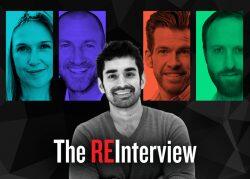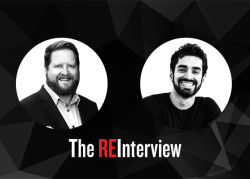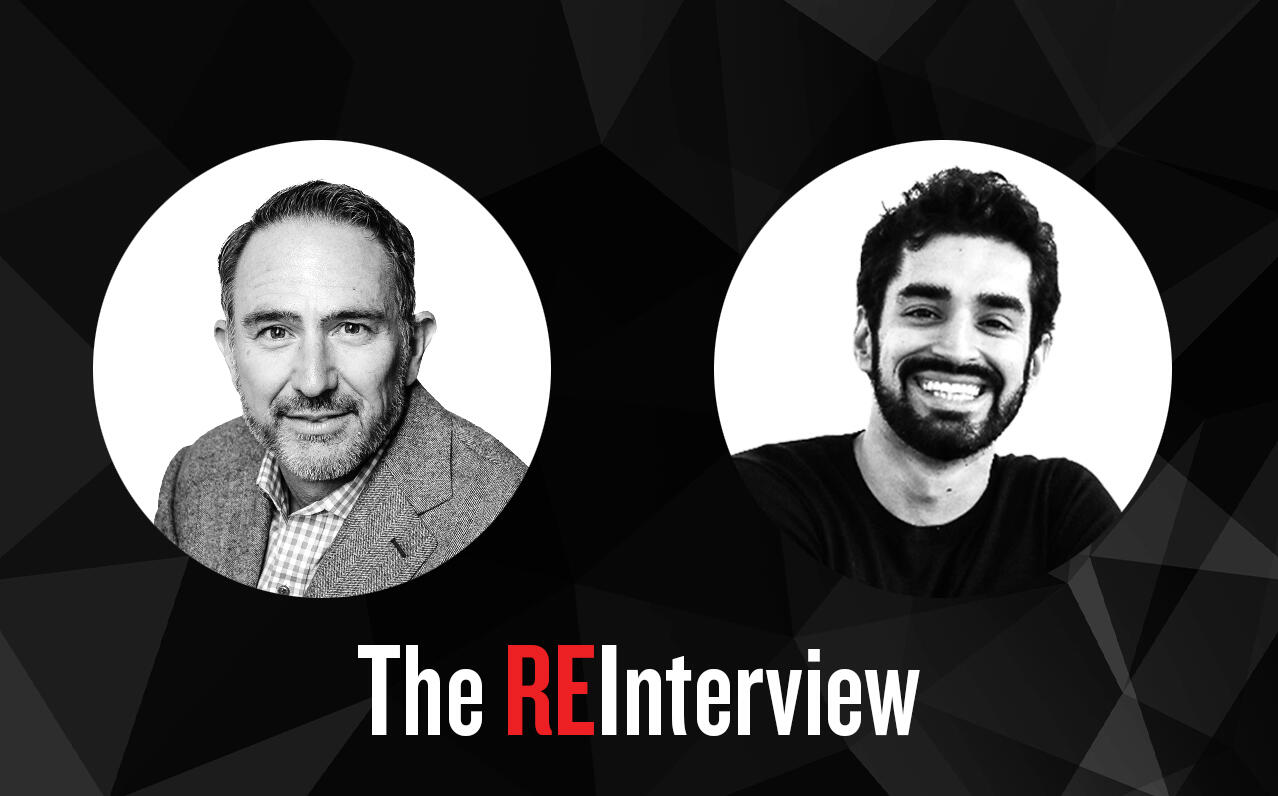“Do you have to live in Atlanta to invest in Coca-Cola?”
Doug Brien is making a point about how provincial single-family rental investing is, with people tending to buy within driving distance of where they live. That’s because the market, unlike those for stocks and bonds, is messy and opaque.
Things we take for granted in debt and equities — reliable data, smooth portfolio management — are hard to come by in single-family rentals. Brien speaks from experience: He first took on the sector as co-founder and CEO of Wall Street-backed Waypoint Homes, which he built into a $3 billion, 17,000-home behemoth that is now part of Invitation Homes.
His focus now is Mynd, a startup he founded in 2016 with his Waypoint partner Colin Wiel to transform how such rentals are managed.
The startup operates close to 13,000 single-family rentals on behalf of both retail investors and institutions such as Invesco, which committed $5 billion to the firm last year for acquisitions. Mynd has also raised nearly $200 million in venture capital, including $57 million in September at a valuation north of $800 million.
Brien, who began real estate investing after a career as a Super Bowl-winning placekicker, sees property management as the fulcrum upon which single-family sits. He spoke with The Real Deal about how investor interest, cloud computing and more adventurous homebuilders are ushering in a creative era for the sector.
Companies like yours talk about “democratizing investment,” but often end up becoming a more efficient investment vehicle for the big guys.
We’re a management platform. We help others execute their investment strategies. And we started with retail investors. If you look at single-family, that really is the market. To your point, we did a deal with Invesco last summer. It’s funny, even some of our own team have raised the question: “We’re trying to democratize access to real estate for all. What are we doing with Invesco and other institutional partners?”
Part of what I had to explain to them is, if you think about Invesco or any of these other institutional investors, they’re deploying capital on behalf of endowments and pension funds. What does that mean? It’s teachers and firefighters and police, folks that work hard their whole lives and this is their savings that they’re going to get back in the form of a pension. And single-family rental is a really good asset class on a risk-adjusted basis. So yes, there’s professional investors in front of them, but really we are providing accessibility to an asset class that we know really well, that we believe there’s a 21st-century way to invest in, and we want to be the pioneers in making that happen.
Why is this happening now as opposed to 10 years ago?
It’s three things. One was the foreclosure crisis — that was the fire sale, the economic impetus to go take some risk. The other two components are the advent of cloud computing and mobile computing. Prior to those technologies, you had folks running around with yellow pads of paper, going out to a house, writing down some notes. As we started building our system, they had iPads and they could get whatever information they needed, not only about that house, but the portfolio, the area, and could input data into the system. All of a sudden the asset class became manageable.
You could argue that it wasn’t really a unified asset class before. Now I’ve heard numbers as high as $4 trillion.
$4.5 trillion is the number we show in our investment deck, which makes it the largest asset class in the world. What made it institutional was a 10- to 12-year track record of real operating data. And then the final straw was Covid. We want to see how an asset class behaves during an economic downturn, and single-family was a shining star. And so, in 2011 and 2012 the private equity firms were coming in, but 2020 and 2021 were the big years when the traditional commercial real estate investors came in. We were deploying capital for GI Partners, and I and one of their partners went up to Sacramento to pitch CalSTRS [California teachers’ pension fund]. And I think they literally thought about our talk for 10 years before they started buying anything. That’s just how that capital behaves.
They have been burned pretty badly on some more speculative investments, like Stuy Town.
Yes. So they are careful, but that type of an investor, they are now in. Invesco changed the name of their “multifamily” group to “residential” and their goal is to have as much single-family as they do multifamily.
We started with property management. This is an important point about single-family: In almost every asset class within real estate, property management is considered a commodity. It’s like, “We’ll find somebody to manage it, it doesn’t really make any difference” — except for single-family, where it’s actually property management PLUS logistics management. We used to always say, “We’re a property manager, plus we’re FedEx.” No single asset has enough revenue to support a full-time employee; you have to manage it portfolio style, which necessitates a lot more technology.
What does that look like in the field?
Unlike traditional real estate where people are assigned to a property, here they’re assigned to a portfolio, which is typically 200 to 400 properties and they can be spread out all over Atlanta. And so how they spend their day is something that needs to be well thought out so that they’re not just doing the things that need to be done, but also incorporating the idea of prioritization.
I just flew in from Houston, an absolutely massive market. One of the things we talked about was, “Should there be such a thing as a Houston vendor? We need to be breaking this down into submarkets.” These are the types of challenges that we have to grapple with in single-family, so what you end up with is a pretty big difference between a good manager who has the technology backbone to support the operation at a high-growth pace and at scale versus those that don’t.
A home is still the most emotional asset. When there are big investors involved, it can come with a lot of bad press often and that can lead to more regulation.
I’m sitting here in the San Francisco Bay Area, the epicenter of residential real estate regulation. I own properties myself here. Think of Maslow’s hierarchy: Shelter is one of the most basic necessities, and we take that responsibility seriously. Our job is to educate our investors on why taking care of their residents, making sure that they have a good home, is good business. They stay longer, they pay on time and they take care of the assets. [Small] investors can be very emotionally charged because in some cases it’s their life savings in that one rental house.
Having said that, yes, as you get big, there’s always going to be a target on your back. I do think a lot of the aggression aimed at institutional investors is somewhat misguided. I remember firsthand in 2009, 2010, 2011, the market stopped falling, but it was flat and you had nice neighborhoods that had turned into flat-out dangerous places to be, there were boarded-up homes everywhere, squatters living in them, dealing drugs out of them. And we at Waypoint would come in and were buying aggressively in some of these neighborhoods, but we were investing $30,000 into these homes. Making them nice, making them livable, making it so other families would move in and we would have the neighbors come up and want to give us hugs. And so you kind of have to take a little bit of a walk down memory lane to remind ourselves that institutional capital kind of saved the housing market to some extent.
Home prices year-over-year are up 20 percent. In some markets, 30 percent. Institutional ownership is still a drop in the bucket, but institutions do have access to cheap debt. Their ability to buy homes at scale is being fingered as one of the reasons for increasing unaffordability for average homeowners.
Some markets have more robust institutional investment than others. None of them are really more than 20 to 25 percent of the buying activity. But one thing to keep in mind is institutional investors are still economic buyers — there has to be some economic rationale. Can they typically get lower debt? Yes. But end-user homeowner buyers are not economic buyers. People will pay as much as they possibly can — it’s not an economically rational decision.
We have an affordability problem, both in terms of owning and in terms of renting. And I’d love to be a part of the conversation of how we build more supply. I live in the worst metro in the U.S. in terms of Nimbyism and you cannot build new supply. So guess what, you have an imbalance that’s driving both rents and prices. If we built enough homes there’d be plenty for renters and owners and pension funds via institutional buyers. Prices and rents could be set at reasonable levels that work for everybody.
Are you involved at all, directly or indirectly, in any lobbying related to the single-family rental sector?
Starwood Waypoint was one of the four companies that helped to form the National Rental Home Council, which Mynd is a member of. The NRHC is the tip of the spear for representing single-family rental. I’ve been involved with some discussions with the mayor of Oakland around ideas for affordable housing.
Read more from The REInterview



You recently called built-to-rent “a gateway drug” for large investors and have been actively courting landlords and developers in that space.
The reason that I jokingly refer to it as the gateway drug is because I’ve been in so many of these conversations over the last dozen-plus years, where most institutional investors are accustomed to large multifamily. So you explain to them that we’re going to invest in distributed single-family homes, and they’re like, “Hold on a second. I own an apartment building, 300 units, I got six people. They’re all there.” Their heads kind of explode around the idea of how do I do all these houses?
And so what you have with built-to-rent, purpose-built communities is you might have 200 to 400 houses. It’s the same asset. But it’s in one area. You can have that community front office with some amenities and a local team that does everything. So [investors] are doing single-family rental, but in a way that’s more familiar to them.
Our hypothesis is that you’re getting a lot of the big multifamily investors coming into single-family via built-to-rent communities. They’re going to get good returns. And then as those product types start to get more expensive and you get cap rate compression, they’re going to want to branch out and also own houses, which will require portfolio-style management, which is what we specialize in.
It’s almost like a geographic security blanket. I know Lennar and other big builders have dived into built-to-rent. You wouldn’t be co-developers with them – instead, you’d be at-scale property managers?
We’d charge a traditional property management fee, leasing fee, renewal fee. And then when we’re buying homes for investors, we get a brokerage-like commission.
On the retail side, most of what we sell is built-to-rent. Lennar is a big public company. They were the first builder to get it. We have seen a big opportunity with smaller regional builders who don’t have the kind of balance sheet that a Lennar or a Pulte has. And so we partner with them and we can take down parts of their communities and pay them as they go and make their business work better. So we’re not necessarily buying the entire community, but maybe we buy 10 or 15 homes out of 40. And for us, those are great individual homes to put into the hands of individual retail investors who want to get access to single-family.
Would you go, say, to some small to midscale developer that has a plot outside Scarsdale and wants to do a built-to-rent?
In fact, we have a 40-home community that we actually bought on our balance sheet and are reselling to another investor and we’re going to manage for them. So there’s different ways we can play. We can take down deals ourselves, we can resell them. But our whole model is you get the property management right — we didn’t do anything but property-manage and build all the associated technology for four years.
If you think about all the services that one needs to successfully deploy capital — brokerage, financing, insurance — they’re all transactional. The enduring relationship is the property manager. It’s also where the really valuable data lies. And so if you can earn trust in that enduring relationship, collect all the relevant data, it puts you in a pole position to be there and just say, “Okay, would you like to now thoughtfully grow your portfolio? We’re in 25 different markets. We can help you buy here. We can help you finance. We can help you make it really easy and get you institutional-type pricing.”
Property management is also probably the stickiest factor, right? If a home is well managed, it’s probably the reason to stay. Conversely, my home could be in a great location, but if I’m getting shitty maintenance, I am moving.
Taking it even one step further: The way that the industry works, which is not the way it should work, is you go to a broker because you’re trying to buy a house. You want to buy an investment property and they give you a pro-forma. And it’s like, “Okay, how do you know that repairs and maintenance is going to run me this much?”
The broker’s trying to sell the property. So they’re basically fabricating numbers. The beauty of having all this data is we can use actual operating data from our own business. We can have feedback loops and tell investors, “Look, if you have a 1980 home in this market of this square footage, this is the range at which it’s going to perform.”
The way that you invest in real estate is to understand your risk and reward. And you study various markets and you have a diversified portfolio that blends to those return criteria. The tools we are building are enabling Main Street and institutional investors to more thoughtfully deploy capital.
The stat that I get stuck on is 180 million Americans own stock and 10 million own [investment] real estate. Why is it that only 10 million own fee simple real estate? The reason is because it’s hard.
Mynd has raised close to $200 million in venture capital, with the latest disclosed valuation north of $800 million. What’s the next step in your evolution?
Geographic expansion is a necessity — becoming the platform that can be in all the most relevant single-family markets and allow investors to use one platform to deploy, finance and manage in 40 to 50 markets, that is a big competitive differentiator. We’re also looking at some financing products that can reinvent what it means to finance a property for retail investors. We call it one-click investing, where Mynd is basically the lender, and we’re not even looking at the individual — we’re just looking at the asset.
We control the dollars. And so we pay ourselves the financing costs first and we can set up an institutional-caliber facility that individuals can leverage. Helping retail investors more efficiently finance, including power buying, going out onto the market as an all-cash buyer to be more competitive, by virtue of the fact that we’re also an institutional investor. And then also looking at some other interesting synergies that we call, “sell with Mynd” or “sell to Mynd.” So think iBuyer in the investment world.
It’s possible for us to basically have an all-cash offer for every single retail home in our portfolio. And if you think about one of the biggest risks or challenges for most retail investors, it’s liquidity. So imagine if in 24 hours you could have all cash, you’re out. That’s a product that we’re working on.
Would the lending be from your own balance sheet?
Partnering with banks, but basically leveraging our balance sheet to secure a warehouse line. And then what we ultimately did with that warehouse line, we could securitize it, take more of an institutional approach to financing that individual investors could never do and offer that to them.
And then just to finish out “the sell with Mynd.” We have 4,500 individual investors, we have 10 institutional investors. So if you want to sell, we can take you out quickly, but we can also sell off-market through our platform. And because we have all the data on your property, we can very quickly list your property to folks that are going to want to buy it as an investment property, meaning you don’t have to go clean it up, you don’t have to vacate your property. And we can do that transaction for less than you would incur on the open market.
I saw that you were also buying through iBuyers. Are you partnered with any specific player?
We’re iBuyer-agnostic. There’s probably eight to 10 different iBuyer-alternatives, MLS bulk portfolios, as well as built-to-rent. We have teams out scouring the market, looking for those deals.
We are in an amazing marketplace with tons of rental demand, tons of investor demand. These are the things you like to see in your business. The flip side of that coin is it’s hard to buy — it’s competitive. And since we do it all ourselves, we don’t just go buy houses. We buy houses that we have to manage and, and, you know, turn into returns for Invesco and pension funds and retail investors.
Ballpark, what kind of returns are they looking for in this game?
Specific buy boxes is not something that I can talk about, but institutional capital is now buying in the mid-4 percent cap rate, depending on the market. It’s meaningfully compressed.
Colin and I just came out with a new book called “The Big Long.” I remember back in 2008, 2009, ’10, ’11, we would be looking at eight caps and be like, “Yeah, we’re gonna pass.” Now we’re trying to buy 4.5 caps! So the world has changed.
What are you trying to get at in the book?
It’s a story about our journey from Waypoint to Mynd and where we see proptech going. A lot of things we talk about are very central to our thesis, using smart home technology to create a better experience for residents. And then, eventually owning [the ecosystem]. I mean, Amazon is an extreme example, but if you think of their business, it started with books and now they’re literally being FedEx.
They own the rails, the undersea cables, God knows what else.
Our hypothesis is that once you earn the trust of the investor and the resident, there’s so many different services around housing that we are now uniquely positioned to offer. We kind of own the payment gateway. So residents pay us rent, we pay investors and it just puts us in a very good place to be able to add value throughout that value chain. And it started with buying houses one at a time back in 2009.
We’ve just always seen this as an emerging industry — why wouldn’t it be? Look at other industries, the institutionalization of coffee shops with Howard Schultz and Starbucks, or 7-Eleven with the corner grocery store. Once these asset classes go institutional, they just tend to never go back. And there are these amazing opportunities with modern technology to create highly differentiated game-changing experiences. The book just kind of takes you through that whole thought process and evolution.
The Big Long. If you made a movie about that, it’s just not as dramatic as The Big Short.
Read the book and then tell me. There are some hilarious stories. Think of what we were doing — it had never been done before. These were crazy times. We were buying houses and there were squatters in them. We were trying to buy houses in foreclosure on the courthouse steps and people were getting indicted and going to jail. This was the Wild, Wild West that we had to navigate.
This interview has been condensed and edited for clarity.

(Write to Hiten at hs@therealdeal.com or @hitsamty on Twitter. To check out more of The Real Estate Interview, a series of in-depth conversations with real estate leaders and newsmakers hosted by Hiten Samtani, click here.)
